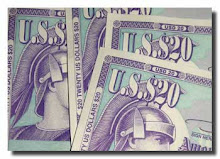March 3 (Bloomberg) -- Manufacturing in the U.S. contracted in February at the fastest pace in almost five years, pushing the economy closer to a recession.
The Institute for Supply Management's manufacturing index dropped to 48.3, the lowest level since April 2003, from 50.7 in January, the Tempe, Arizona-based group said today. Fifty is the dividing line between contraction and expansion.
The collapse in housing is rippling through the economy as consumers curb spending and factories reduce production of furniture, automobiles and appliances. Credit restrictions may continue to hurt economic growth, prompting Federal Reserve policy makers to lower interest rates again this month.
``The evidence is piling up that the economy is slipping into at least a mild recession,'' said Scott Anderson, senior economist at Wells Fargo & Co. in Minneapolis, who forecast the index would drop to 48. ``With the much higher food and energy prices and restricted credit, there are not a lot of avenues for consumers to continue to spend.''
Economists surveyed by Bloomberg News forecast the index would fall to 48, according to the median estimate of 68 economists. Economists' forecasts ranged from 45 to 51.
New orders decreased to 49.1 from 49.5, while a production measure dropped to 50.7 from 55.2, ISM said. A gauge of supplier deliveries fell to 50.1 from 52.8 in the prior month.
The group's measure of prices paid decreased to 75.5 from 76 in January. Economists had forecast the measure would fall to 73.
Fewer Inventories
The inventory index in today's ISM report slumped to 45.4 from 49.1. Figures less than 50 mean manufacturers are reducing stockpiles. ISM's employment measure declined to 46 from 47.1.
Today's factory survey corroborates other regional business polls in the past two weeks that showed factory activity, which accounts for about 12 percent of gross domestic product, contracted in February.
The National Association of Purchasing Management-Chicago reported Feb. 29 that business activity fell to the lowest level in more than six years. A Philadelphia Fed gauge showed the deepest contraction in seven years, while the Fed Bank of New York's economic index was the weakest in almost five years.
Government data also have pointed to a slowdown. Orders for durable goods excluding transportation equipment fell in January for the third time in the last four months, Commerce said last week. Factory production stalled in January, with car output falling, the Fed said Feb. 15.
Housing Slump
A third year of declining home construction will drag on growth again this year, costing jobs and undermining the consumer spending that accounts for two-thirds of the economy. As property values decline, Americans feel less wealthy and buy fewer televisions and cars.
Sales at General Motors Corp., Ford Motor Co. and Chrysler LLC, which account for about half of U.S. auto purchases, probably fell at least 14 percent in February from a year earlier, according to a Bloomberg survey of analysts before an industry report today.
Demand for cars is at the ``low end'' of the range forecast, said George Pipas, chief sales analyst for Ford, in Dearborn, Michigan, on a conference call last week.
The economy will grow at a 0.5 percent annual rate from January through March, capping the weakest six months since the last economic slump in 2001, according to the median estimate of economists polled by Bloomberg from Jan. 30 to Feb. 7.
The Fed, which has lowered the benchmark rate by 2.25 percentage points since September, is ready to continue cutting borrowing costs if needed, Chairman Ben S. Bernanke told Congress last week.
Growth Risks
He warned that risks to the outlook include ``the possibilities that the housing market or the labor market may deteriorate more than is currently anticipated and that credit conditions may tighten substantially further.''
One of the few bright spots is record exports as a weak dollar and growing economies in countries such as China, Brazil and Mexico stoke demand for goods to modernize their infrastructure and production capacity.
The ISM's measure of export orders decreased to 56 from 58.5, showing foreign demand is still growing, though at a slower pace.
``We certainly have seen among some of our customers and even in our own business some benefits from a weaker dollar in terms of increased strength in an export capacity,'' Frank MacInnis, chairman of in Norwalk, Connecticut-based EMCOR Group Inc., a construction and facilities-management company, said in a Bloomberg Television interview last week.
To contact the reporter on this story: Bob Willis in Washington at bwillis@bloomberg.net

